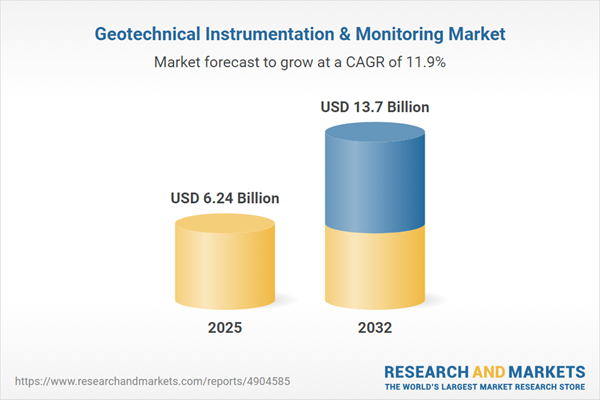Speak directly to the analyst to clarify any post sales queries you may have.
Geotechnical instrumentation and monitoring systems are now integral to senior leaders overseeing infrastructure, energy, mining, and public sector assets. These solutions support effective project governance by enabling early risk detection, operational transparency, and adaptive compliance strategies suitable for dynamic project environments.
Market Snapshot: Geotechnical Instrumentation & Monitoring Market Trends
The global geotechnical instrumentation and monitoring market is experiencing strong expansion, valued at USD 5.58 billion in 2024 and projected to grow to USD 13.70 billion by 2032. This increase, reflected in a compound annual growth rate (CAGR) of 11.86%, results from rapid uptake of integrated sensor technologies and evolving data analytics. Increasing attention to site safety, regulatory compliance, and asset transparency are primary drivers. As the adoption of real-time data capabilities accelerates, organizations gain crucial insights that improve project decisions and enhance reliability in complex project settings. The trend toward data-driven, instantaneous monitoring is reshaping how companies address growing compliance requirements and stakeholder expectations across sectors.
Scope & Segmentation: Critical Segments and Regional Dynamics
- Instrument Types: Includes accelerometers, data loggers, extensometers, inclinometers, load cells, piezometers, strain gauges, and tilt sensors, each chosen to track shifting site conditions and support asset integrity initiatives.
- End Users: Encompasses construction firms, energy operators, mining groups, oil and gas sector entities, and agencies managing public transport, all using monitoring systems to secure investments, maintain compliance, and control operational risks.
- Monitoring Modalities: Covers geotechnical and structural health monitoring solutions that provide broad risk assessment and support ongoing infrastructure oversight in varying operating environments.
- Platforms: Features portable systems for rapid site assessments and stationary units for long-term, continuous monitoring, granting flexibility across project types and risk profiles.
- Installation Types: Covers surface and subsurface deployments for adaptable solution integration, spanning urban, remote, or regulation-sensitive locations where project safety is paramount.
- Technologies: Involves wired systems with robust fiber optic and electric cable networks for established assets, contrasted with wireless solutions, such as cellular IoT, LoRaWAN, and satellite, serving areas with challenging connectivity.
- Regions: Solutions are designed for diverse markets in the Americas, Europe, Middle East & Africa, and Asia-Pacific, promoting regulatory alignment and responsive infrastructure strategies in each region.
- Key Companies: Major providers, including Geosense Limited, Geotech Environmental Equipment Inc., Geokon Inc., SISGEO S.p.A., Campbell Scientific Inc., Encardio-rite (India) Pvt. Ltd., RST Instruments Ltd., GeoSIG Ltd., Kinemetrics Inc., and Soil Instruments Limited contribute specialized expertise across numerous global projects.
Key Takeaways: Strategic Insights for Senior Leaders
- Adoption of integrated monitoring systems enhances real-time visibility and robust asset governance throughout project lifecycles, supporting effective resource oversight in critical sectors.
- Advanced sensor networks and cloud-based analytics streamline operational workflows, automate alerts for potential threats, and maintain consistent productivity across centralized and geographically distributed assets.
- Artificial intelligence and edge computing foster early anomaly detection and predictive maintenance practices, extending the functional lifespan of critical infrastructure and increasing reliability.
- Deploying modular system architectures simplifies compliance, enables more efficient standardized reporting, and supports sustainability efforts through consistent high-quality data acquisition.
- Region-specific deployment strategies allow organizations to tailor solutions for local regulatory requirements, operational conditions, and risk factors, improving outcomes for global projects.
- Strong vendor relationships and the use of scalable solutions facilitate nimble responses to regulatory or technological shifts, ensuring ongoing project adaptability and strategic flexibility.
Tariff Impact: Strengthening Supply Chain Resilience
Recent tariff adjustments have led companies in the geotechnical monitoring sector to reassess sourcing and manufacturing routes. An increasing number are turning to domestic production and optimized inventory management. These efforts address potential equipment shortfalls and minimize risks to project schedules caused by international trade uncertainties. By focusing on local capabilities and responsive planning, organizations achieve greater continuity in project delivery amid unpredictable trade conditions.
Methodology & Data Sources
This market analysis is informed by direct interviews with geotechnical engineers, procurement officers, and project managers, as well as reviews of key industry standards, academic publications, and proprietary datasets. This combined approach provides a practical knowledge base for senior decision-makers considering strategic investments.
Why This Report Matters: Value for Senior Decision-Makers
- Offers senior leaders a structured framework to refine resource allocation and improve project efficiency in response to evolving regulatory environments and complex project demands.
- Supports decision-makers in overcoming procurement challenges while advancing sustainability objectives across diverse asset portfolios.
- Guides organizations to establish adaptive asset management processes and resilient supply chains, helping them operate confidently in the face of disruptions and shifting regulations.
Conclusion: Empowering Proactive Risk Management
With these insights, senior leaders can anticipate challenges, reinforce risk management strategies, and ensure their organizations stay future-ready as new regulations and technologies shape the market.
Additional Product Information:
- Purchase of this report includes 1 year online access with quarterly updates.
- This report can be updated on request. Please contact our Customer Experience team using the Ask a Question widget on our website.
Table of Contents
3. Executive Summary
4. Market Overview
7. Cumulative Impact of Artificial Intelligence 2025
Companies Mentioned
The companies profiled in this Geotechnical Instrumentation & Monitoring market report include:- Geosense Limited
- Geotech Environmental Equipment, Inc.
- Geokon, Inc.
- SISGEO S.p.A.
- Campbell Scientific, Inc.
- Encardio-rite (India) Pvt. Ltd.
- RST Instruments Ltd.
- GeoSIG Ltd.
- Kinemetrics, Inc.
- Soil Instruments Limited
Table Information
| Report Attribute | Details |
|---|---|
| No. of Pages | 186 |
| Published | October 2025 |
| Forecast Period | 2025 - 2032 |
| Estimated Market Value ( USD | $ 6.24 Billion |
| Forecasted Market Value ( USD | $ 13.7 Billion |
| Compound Annual Growth Rate | 11.8% |
| Regions Covered | Global |
| No. of Companies Mentioned | 11 |









